
Guests
- Marine Sergeant Adam Kokeshmember of Iraq Veterans Against the War.
- Private First Class Evan Knappenbergeron Thursday, he wrapped up an eight-day, 24-hour vigil in Bellingham, Washington, to protest the military’s stop-loss policy. Stop-loss allows the military to extend soldiers’ tours of duty and send them back to Iraq.
Last week, a military panel recommended that Marine Sergeant Adam Kokesh have his honorable discharge revoked for wearing his uniform during an antiwar protest. We also speak with Private First Class Evan Knappenberger. On Thursday, he wrapped up an eight-day, 24-hour vigil in Bellingham, Washington, to protest the military’s stop-loss policy.
Transcript
AMY GOODMAN: We turn now to two Iraq War veterans who are drawing the ire of the Pentagon for their vocal opposition to war. A military panel is recommending Marine Sergeant Adam Kokesh have his honorable discharge revoked for wearing his uniform at an antiwar protest. Kokesh is a member of Iraq Vets Against the War. The military began investigating him after The Washington Post published a photograph of him at an antiwar protest in March to mark the fourth anniversary of the war. Adam Kokesh also spoke last month in uniform during a Memorial Day protest here in New York.
ADAM KOKESH: When we say bring our brothers and sisters still in Iraq home now, who are we talking to? The electorate said it last November, but we have yet to see any results. We are the weapons of this democracy, ruled by the people, but our democracy has failed us. It is time for the people to end this war.
AMY GOODMAN: Marine Sergeant Adam Kokesh, speaking here in New York last month. Today, Adam joins me from Washington, D.C., and we’re joined on the telephone across the country by Private First Class Evan Knappenberger. On Thursday, he wrapped up an eight-day, 24-hour vigil in Bellingham, Washington, to protest the military’s stop-loss policy. Stop-loss allows the military to extend soldiers’ tour of duty and send them back to Iraq again and again. Evan Knappenberger on the phone with us from Bellingham.
Let’s start in Washington, D.C. Sergeant Adam Kokesh, talk about your situation right now, your protest in uniform. Why did you decide to wear your military uniform?
ADAM KOKESH: Well, good morning. That’s a very good question, because a lot of the coverage has grossly simplified the issue and said that I wore my uniform to a protest, which isn’t really accurate at all. What we were doing was conducting something called Operation First Casualty. And it’s called that because it has long been said that the first casualty of war is the truth. And so, what we did was conduct a mock combat patrol through the streets of Washington, D.C., in order to bring a small part of the truth of the occupation home to the American people and give them a small sense of what it’s like to have squads of men in uniform, with rifles—although we were simulating them, of course—running around the streets of their city. And we also had civilians playing affected peoples. They weren’t playing Iraqis or pretending to speak Arabic or anything like that, but we treated them as we would treat Iraqi civilians on a daily basis. And so, it was more street theater than general protest, and I don’t need to show up to a protest in a uniform to represent myself as a veteran. But for this particular demonstration, we were simulating a combat patrol, and so that’s what we did, and that’s why it was appropriate in that setting. Now, normally, as I did in—or as I am doing today, I should say, I wear this Marine Corps boonie cover, and that’s how I choose to represent myself as a veteran.
AMY GOODMAN: Were you surprised after the protest when the military decided to investigate, after your photograph appeared in The Washington Post?
ADAM KOKESH: Yeah, absolutely surprised. And the first thing that I got was an email from Major John Whyte of the Marine Corps Mobilization Command, informing me that he was investigating my case and that I may be in violation of certain rules and regulations and so on. And my first reaction was surprise, absolutely, but also shock. And I was a little confused to see that the military was investigating a member of the inactive reserve, who had been discharged honorably and was getting on with his life. And I was—and then, upon reflection, I was deeply offended to see, you know, when I realized the implications of this, that the time of an active-duty major is being used to investigate marines in the inactive reserve on political grounds and based on their political activities. And I wrote him back a scathing email chastising him for wasting his time, while we have marines dying every day in Iraq, on such a petty issue. And I said this is not what Marine Corps leadership is supposed to be about. And I concluded by telling him, “So, no, I am not writing to—or not responding to recognize my responsibilities under the rules and regulations, but rather to ask you to kindly please go f— yourself.” And, of course, in the email I spelled it out, because that’s how marines talk to marines.
AMY GOODMAN: And now they are recommending that your honorable discharge be revoked?
ADAM KOKESH: Well, that’s not exactly accurate either. But as a result of this email that I sent and the photographs of me taking part in this operation in uniform, the investigating officer recommended that I be separated from the inactive reserve with an other-than-honorable discharge. And the way it works is that you may receive multiple discharges throughout your military career. But it’s your last one that is relevant in terms of your benefits. And so, they would separate me and give me a new discharge, which normally you wouldn’t even get from the inactive reserve—your time would simply expire—and that would supersede my honorable discharge that I received for my service on active duty.
AMY GOODMAN: And what would that mean in your life, to have an other-than-honorable discharge? Does that mean a dishonorable discharge?
ADAM KOKESH: Well, yes, there’s, you know, a few categories, and it goes from honorable to general and then other-than-honorable, before bad conduct and dishonorable. But other-than-honorable is across that line where my benefits would be revoked, essentially. I would not be qualified for the healthcare that I’m receiving now through the VA. I would lose the lifetime treatment for my service-related injuries, namely, my elbow bursitis, which I may need an operation on soon, and my hypertension, which I developed at the age of 23 upon returning from Iraq. And theoretically, I might have to pay back some of the benefits that I got as a stipend as a reservist going through college through the GI Bill.
AMY GOODMAN: I want to ask you in a minute about your time in Iraq, but I first want to go to Specialist Evan Knappenberger, also an Iraq War veteran, just finished up an eight-day, 24-hour-a-day vigil in Bellingham Washington, also wearing his fatigues, standing outside the federal building. Evan Knappenberger, can you tell us what you did?
EVAN KNAPPENBERGER: Well, yes. I decided a couple weeks ago that I needed to do something to effect a positive change in all these kind of negative things going on, and I figured the best way to do that would be to draw some attention to these policies that the military is using to fight this war without actually—you know, a war without conscription, basically. So, in the middle of the night, I had this great idea, just a symbol of something kind of similar to what Operation First Casualty is, you know, to bring the war to the American people, because there is a big disconnect between the civilian population and those of us who were in Iraq. And we can see—us veterans of Iraq, we understand kind of the way that these policies get perpetrated, and the American people need to be made aware of that. So I had this great idea to bring that home and ended up on a tower for eight days.
AMY GOODMAN: Ended up what?
EVAN KNAPPENBERGER: I ended up sitting up on this tower for eight days, wearing my uniform, kind of like I did in Iraq, when I was guarding these fields in Iraq.
AMY GOODMAN: What fields? Where were you in Iraq?
EVAN KNAPPENBERGER: I was on Camp Taji, which is north of Bagdad, and I ended up—in Iraq, I did 97 nights on this tower, pretty much 10 hours a night, and guarding an empty field and a few shepherds. And I used to think, when I was doing that, what it would look like if I was guarding American soil or doing something actually worthwhile, in my opinion.
AMY GOODMAN: Did you fire your gun in Iraq?
EVAN KNAPPENBERGER: No, I never fired my weapon in Iraq.
AMY GOODMAN: And in Bellingham, Washington, did you build this tower outside the federal building?
EVAN KNAPPENBERGER: Yes, we did. And we were originally going to build a really—like a real, realistic tower. We ended up building a smaller one that would be more effective to talk to people, because the goal—and I got criticized for this—the goal was not so much to be militarily realistic, but we wanted to kind of have some dialogue with people and do a watered-down version.
AMY GOODMAN: Now, Evan Knappenberger, you specifically targeted the stop-loss program. Can you explain what it is and why you feel this is the critical issue?
EVAN KNAPPENBERGER: Yes, the stop-loss program is the military’s euphemism for the policy that they use to extend soldiers without honoring their contractual obligations. They break their contracts to get them to stay in longer and do another tour, you know, get the most out of the soldiers they have. And it’s not really legal. We’ve been checking into the legality of it. It’s very, very shady. It’s one of those things. I had a reporter in Chicago describe it to me as “better to ask forgiveness later.” And I think it’s wrong, and I think it’s completely unjust.
AMY GOODMAN: How many times have you been in Iraq?
EVAN KNAPPENBERGER: I served a year in Iraq.
AMY GOODMAN: Sergeant Adam Kokesh in Washington, D.C., where were you in Iraq, and how long were you there?
ADAM KOKESH: I served in the Fallujah area as a sergeant on a civil affairs team from February to September of 2004.
AMY GOODMAN: Were you there during the siege of Fallujah?
ADAM KOKESH: Yes, I was there for the siege, the first battle of Fallujah in April, for 18 days.
AMY GOODMAN: What happened there? What did you do there? What did you see?
ADAM KOKESH: Well, the infantry company that I was attached to was responsible for blockading the two bridges across the Euphrates coming out of Fallujah. And one of those bridges is the one that leads to the Fallujah General Hospital on the peninsula there. And so, part of our job as a civil affairs team was to ensure that hospital had what they needed to continue to operate, and to run a checkpoint on the bridge so that people that actually needed medical attention could get across and get that. And there was a village that was cut off by our perimeter, and so we were distributing humanitarian rations to them, as well.
AMY GOODMAN: Did you fire your gun?
ADAM KOKESH: No, fortunately, I was not faced with that responsibility. I had my share of combat. I got bullets bouncing off my door on a number of convoys, and a few ambushes, and received a lot of indirect fire. But every time we were being fired at, I was either driving or behind somebody. And most of the people that were firing were shooting at windows or shadows anyways.
AMY GOODMAN: And your estimation of the number of casualties in Fallujah, under siege twice by the U.S. military?
ADAM KOKESH: Oh, well, there are experts who have tried to calculate, you know, how many there were, but we basically took a city that was 250,000, and 500,000 in the surrounding area, and decimated it. And there’s a huge displaced persons crisis because of that. A lot of people left the city, a lot of people that we let evacuate during the siege, and God only knows how many people actually died within the city limits of Fallujah during that siege and during the second battle in November.
AMY GOODMAN: Sergeant Kokesh, you also protested at the Alberto Gonzales hearing last month, the attorney general of the United States, and you held up a sign. Can you talk about what your point was and what was on that sign?
ADAM KOKESH: Absolutely. Well, I held a tally board, where on one side it said, “I don’t recall,” and on the other side I had tally marks for every time Alberto Gonzales said those words or something very close to that effect. Again, it’s silly being called a protester there, because in most of the coverage, you know, nobody, of course, got my name. But more importantly, I wasn’t even protesting anything. If anything, I was cheerleading the Democrats that were—and the Republican senators, as well, that were holding the attorney general’s feet to the fire. I think that was a really important role for them to play, and I just wanted to encourage them and say, you know, “Don’t pull any punches.” And this was an idea we just briefly discussed the night before and thought, “Well, what are we expecting out of this testimony?” And it was clear that he was going to do something to get out of it. It just so happened that he used the phrase “I don’t recall” 74 times. And frankly, I thought that the Bushies would be on better message and wouldn’t screw up like that. And I actually had written numbers written down on individual sheets, and I was flipping through, and I got all the way up to 15, and I ran out of paper. So I had to start doing tally marks. You know, my original intention wasn’t even to do tally marks. But someone had told him that I was in the audience, and after lunch, for about 20 minutes, he didn’t say, “I don’t recall,” once before losing it again. But he also said, “I don’t,” and caught himself at least a hundred times. And I’d like to personally take credit for making him sound like twice the idiot he would have otherwise. But also, Senator Schumer mentioned, in his closing remarks, the count, of course, without pointing out the protester in the back of the room. So, it was cool that it had an immediate effect, and sometimes, you know, pointing out something, when you have something to point out that’s actually relevant, you know, sometimes standing there holding a sign can actually make a difference.
AMY GOODMAN: I wanted to turn to Specialist Evan Knappenberger again, in Bellingham Washington, as we have this conversation in two Washingtons, from Washington, D.C., to Bellingham. You did your own study of civilian deaths in Iraq. How did you do it, Evan?
EVAN KNAPPENBERGER: I had a month-long project about this time last year, and I used a variety of methods. Basically my job as an intelligence analyst entailed a lot of things. And none of us really got real training on the Iraq scenario. I trained on a North Korea scenario. So basically we were making it up as we went, but trying to be as truthful as possible. I personally read through about 30,000 separate reports of civilian casualties in Iraq and put together a picture over a very long period of time, of the situation around Baghdad as far as what they call SECMAK now, which is sectarian murders and killings. And after a month of reading through these reports, we started to get a picture of what was going on. Unfortunately, it was pretty much ignored by the chain of command.
AMY GOODMAN: You also participated in interrogations, Evan?
EVAN KNAPPENBERGER: That’s right, but we didn’t call them interrogations. The terminology had to be changed, as is the case with many things we do in the military that we’re not really allowed to do. If you change a name, you can—you’re allowed to do it, because it’s not—it’s the same action, just a different name. We call them tactical questionings. And that’s correct, I did do a few.
AMY GOODMAN: Where, and who were you questioning, and who was in the room when you did it?
EVAN KNAPPENBERGER: Well, I can’t really go into specifics, but typically there would be one or two soldiers. At times it would be nobody more than two junior enlisted soldiers and an Iraqi interpreter and the suspect.
AMY GOODMAN: And where would the suspect come from? What kinds of questions were you asking?
EVAN KNAPPENBERGER: Again, I can’t be too specific. But typically, the suspect would be somebody that was, one example, picked up on the street violating a weapons permit. And the kind of questions we would ask were background questions. But if we could establish—the rule was we could hold these guys for 24 hours without doing any paperwork on them. And at the end of that 24 hours, if we had enough on them, we could release—we could keep them in; otherwise, we had to release them. But the problem then became getting something out of them to keep them.
AMY GOODMAN: Back to the study, what did you conclude in terms of civilian deaths in Iraq?
EVAN KNAPPENBERGER: At the time, we had concluded that there were close to three-quarters of a million civilian deaths over the course of the Iraq War. Now I would guess that it’s probably upwards of a million.
AMY GOODMAN: Well, that actually coincides with the two studies done, most recent, a million, and right before that, The Lancet, the British medical journal, published that study from Johns Hopkins University saying around 655,000 soldiers—rather, civilians, had died in Iraq.
EVAN KNAPPENBERGER: That’s correct. And unfortunately, it took a lot of political pressure from studies like The Lancet study before the chain of command decided that sectarian violence was even a problem. And it was only afterwards that—I think it was after that report was published that they decided to make a task force to investigate these sectarian killings.
AMY GOODMAN: I wanted to ask you about another issue that you looked at, or have experienced, among the soldiers, and that’s the issue of suicide.
EVAN KNAPPENBERGER: That’s correct. Officially, the number, I believe, in Iraq of suicides is 122, as of last week. That doesn’t sound exactly right to me. In my unit alone, we had 45 combat casualties and 15 suicides. And I would think that the 15 suicides, if you traced out the numbers, there would be a third as many suicides as there were combat casualties. I don’t think the 122 suicides number meshes with that.
AMY GOODMAN: Are the suicides back here in the United States when soldiers return?
EVAN KNAPPENBERGER: Oh, those aren’t counted.
AMY GOODMAN: They’re not counted? These are just suicides in Iraq?
EVAN KNAPPENBERGER: Yeah.
AMY GOODMAN: Why are they not counted, the ones when soldiers come home?
EVAN KNAPPENBERGER: Well, I would assume that it’s political in nature. The Army doesn’t want to admit to taking any more losses than they possibly can.
AMY GOODMAN: It’s interesting because in our headlines today we reported on this new study that found the suicide rate of U.S. war veterans is double the rate of ordinary civilians.
EVAN KNAPPENBERGER: It wouldn’t surprise me. And then, that also—that doesn’t include the number of guys who go out and get drunk and die in drunk driving accidents, which in my unit in the month that we were back, I’ve probably lost three or four guys that way, too.
AMY GOODMAN: Well, as we wrap up, Sergeant Adam Kokesh, your thoughts right now, back in the nation’s capital, in Washington, D.C.? The level of support you’ve gotten inside the military from the top down, privately perhaps, people talking to you?
ADAM KOKESH: Well, actually, it’s been quite surprising to see a lot of people from my old unit contacting me and supporting me in my efforts and trying to get—to ensure that the Uniform Code of Military Justice is not applied beyond its jurisdiction into the inactive reserve. And they appreciate that, and I think a lot of people in the military appreciate what I’m doing and why I’m trying to fight this case so hard. Even though the board recommended me for a general discharge last week, which wouldn’t affect my benefits, if it’s approved, it doesn’t do anything to establish a precedent, and the next guy facing the same charges might receive an OTH or something worse potentially. And everyone on active duty is going to be in the IRR at some point, if they’re not past their eight-year contract when they get out of the military, and most are on four-year contracts, and they spend—they stand to spend about four years in the inactive reserve. And if it’s not safe for these combat vets when they come home to speak their minds, then it’s not safe for anyone.
AMY GOODMAN: I want to thank you both for being with us. We will get back to you soon. Sergeant Adam Kokesh, Iraq veteran against the war, was wearing uniform at an antiwar protest, has now—the question is: Will he get something other than his honorable discharge? Specialist Evan Knappenberger, also an Iraq War vet, held an eight-day, 24-hour-a-day vigil last week in Bellingham, Washington, outside the federal building, protesting the stop-loss program, when soldiers are sent to Iraq again and again and again. We’ll link to their websites at ours, democracynow.org. And if you want to see video of their protests and photographs, you can go to our website, as well. This is Democracy Now! Back in a minute.

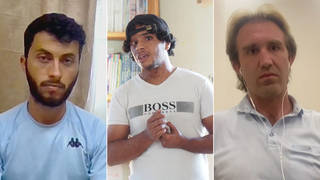
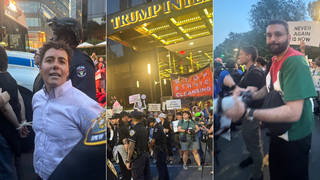
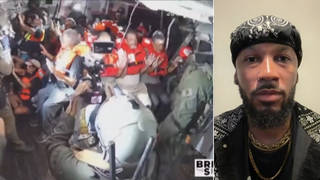
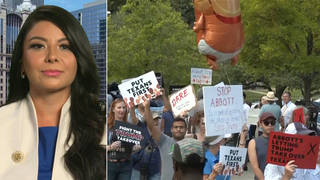

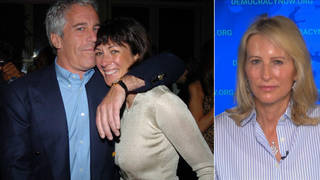
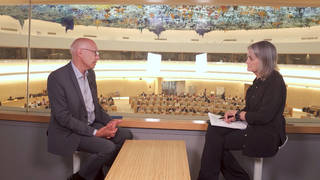
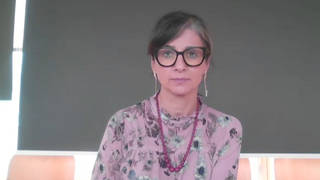

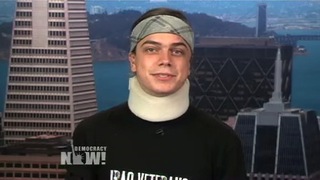


Media Options